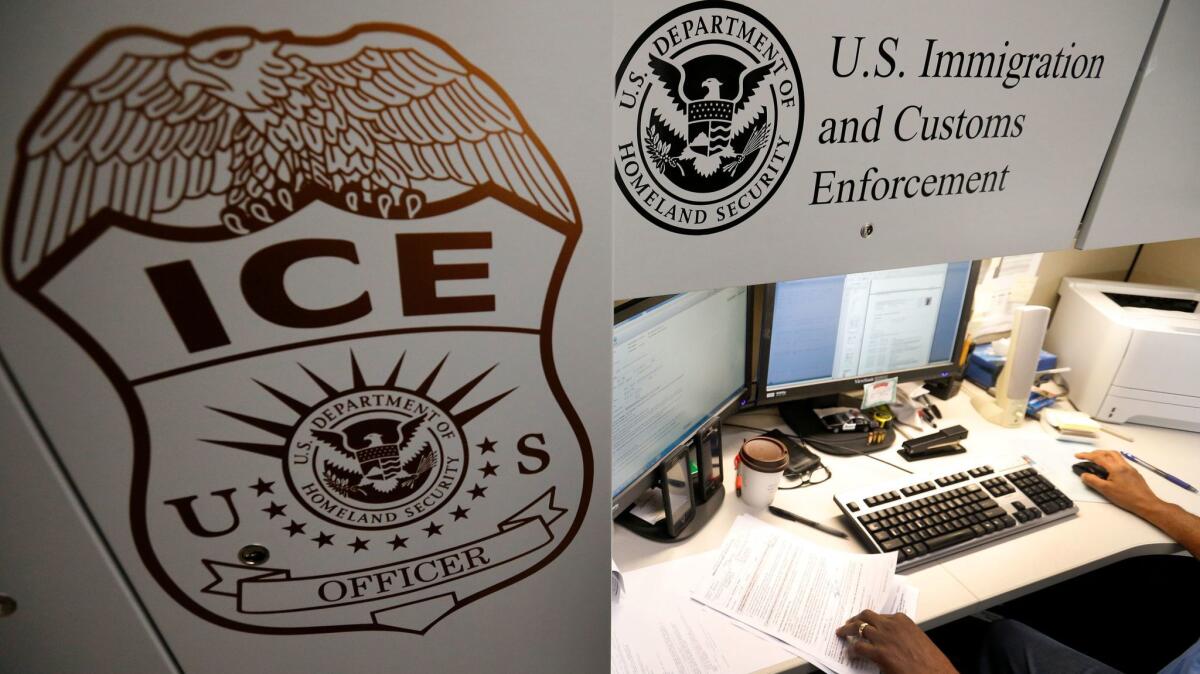Federal judge deals major blow to ICE practice of asking local police to detain people

- Share via
A federal judge in Los Angeles this week issued his final judgment in a long-running immigration case, upending the way Immigration and Customs Enforcement uses local police to detain people it suspects of being in the country illegally.
The judgment filed Wednesday by U.S. District Judge Andre Birotte formalized a ruling he made in September that included a permanent injunction barring ICE from using error-prone databases when issuing so-called detainers, which are requests made to police agencies to keep people who have been arrested in custody for up two days beyond the time they would otherwise be held.
The earlier ruling also blocked ICE from issuing such requests to state and local law enforcement in states where there isn’t an explicit statute authorizing police to arrest someone or keep them in custody on an immigration detainer.
The ruling, which applied to ICE activity in all but a few states, appeared to have enormous implications for how the government targets people for deportation. However, attorneys from the U.S. Department of Justice and civil rights groups that brought the case disagreed over whether the injunction went into effect immediately, and ICE gave no indication it had changed its practices.
Last fall, an ICE spokesman said the agency was “reviewing the ruling and considering our legal options.”
This week’s judgment erased any ambiguity.
Under the judgment, ICE has three months to “adopt and implement any policies, practices, trainings, and systems changes necessary to ensure consistent and effective compliance” with the judgment, Birotte wrote. The judge ordered government lawyers to provide him with evidence it had implemented new policies.
“This judgment ensures that ICE has to comply with the court’s findings that the program it’s had for decades is grounded in unconstitutional practices that have to end,” said Jennie Pasquarella, an attorney with the American Civil Liberties Union, who helped argue the case.
The class-action lawsuit alleged that the databases that agents consult to issue detainers are so badly flawed by incomplete and inaccurate information that ICE officers should not be allowed to rely on them as the sole basis for keeping someone in custody.
In September, the judge agreed with that assessment, finding that the databases often contained “incomplete data, significant errors, or were not designed to provide information that would be used to determine a person’s removability.”
These errors, according to that decision, have led to arrests of U.S. citizens as well as noncitizens in the country lawfully. From May 2015 to February 2016, of the 12,797 detainers issued in that period, 771 were lifted, according to ICE data. Of those 771, 42 were lifted because the person was a U.S. citizen.
In the years since the lawsuit was filed, ICE has amended its policies, saying the changes made the process for issuing detainers more rigorous.
Previously, for example, agents would check individual databases in search of evidence of someone being in the country illegally. But three years ago, the agency launched a new system, in which 10 databases are automatically queried. A supervisor is required to sign off on decisions to issue detainers.
Birotte said in his judgement this week that conducting interviews with people suspected of being in the country illegally and checking the hard copy files the government keeps on immigrants is the most reliable source of information for issuing detainers.
The judge’s decision affects any detainer requests issued by an ICE officer in the federal court system’s Central District of California. That designation is significant because it includes the Pacific Enforcement Response Center, a facility in Orange County from which ICE agents send out detainer requests to authorities in 43 states, Guam and Washington, D.C.
Dozens of deportation officers and contract analysts work in shifts around the clock every day at the center. In 2018, the center issued 45,253 detainers and alerted agents at field offices to more than 28,000 additional people released from law enforcement custody before ICE could detain them.
If ICE tries to move its detainer operation to another facility, Birotte said, it must alert him in advance and the injunction would follow it to the new location.
All existing detainers issued by the enforcement center were also nullified by the judge’s ruling. Pasquarella said it was unknown how many people that affects, but said it is in “the thousands.”
Finally, Birotte gave ICE a month to alert the thousands of local and state police departments to which it sent detainer requests of his judgment and “its impact on detainers issued by ICE.” He ordered ICE to post its notice prominently on its website and said the agency “shall specifically inform these agencies that a detainer does not provide the legal authority for a state or local law enforcement officer to make a civil immigration arrest.”
The detainer process begins when police arrest and fingerprint a person. The prints are sent electronically to the FBI and checked against the prints of millions of immigrants in Homeland Security databases. If there is a match — such as someone who applied for a visa or was apprehended by Border Patrol — it triggers a review process, which often culminates with an agent at the center deciding whether to issue a detainer.
Approximately 70% of the arrests ICE makes occur after the agency is notified about someone being released from local jails or state prisons. In fiscal year 2019, ICE had lodged more than 160,000 detainers with local law enforcement agencies, according to the agency.
An ICE spokeswoman declined to comment on the judgment and would not say whether ICE had yet changed its practice of issuing detainer requests. Instead, she referred reporters to a statement released Thursday by the White House.
“A single, unelected, district judge in the Central District of California issued a legally groundless and sweeping injunction that — if not immediately lifted — will guarantee the release of innumerable criminal illegal aliens into our communities putting citizens at dire risk,” the statement said. “This ruling undermines the pillars of immigration enforcement and blocks traditional and vital law enforcement cooperation that has occurred for decades.”
More to Read
Sign up for Essential California
The most important California stories and recommendations in your inbox every morning.
You may occasionally receive promotional content from the Los Angeles Times.












